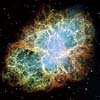| . |  |
. |
Los Angeles CA (SPX) Dec 21, 2006 Scientists working with NASA data recently made a discovery that forced them to re-think their theories on gamma-ray bursts - the most powerful cosmic explosions. A year ago scientists thought they had figured out the nature of gamma-ray bursts. They signal the birth of black holes and traditionally, fall into one of two categories: long or short. A newly discovered hybrid burst has properties of both known classes of gamma-ray bursts yet possesses features that remain unexplained. The long bursts are those that last more than two seconds. It is believed that they are ejected by massive stars at the furthest edge of the universe as they collapse to form black holes. Short bursts persist for less than two seconds, with some only lasting a few milliseconds. The cause is thought to be the merger of two neutron stars - or a neutron star and a black hole - to form a new or bigger black hole. On June 14, 2006, NASA's Swift satellite presented scientists with a burst that doesn't fit into either category. At the time of the event, over a dozen telescopes, including the Hubble Space Telescope and several ground-based observatories, collected data and contributed to the study of this burst. Named GRB 060614 (after the date it was detected), this one has qualities of both the long and short bursts. The existence of this hybrid, coming from 1.6 billion light years away in the constellation Indus, suggests that the black hole birth happened in a different way from other known bursts. The hybrid lasted for 102 seconds, a long burst property. But long bursts are usually followed by a supernova, or star explosion. GRB 060614 had no associated supernova, and is in fact in a galaxy with very few stars that could produce either a supernova or a long burst. No current scientific models can explain the existence of this hybrid burst. Most scientists believe something new may be responsible. Are stars that produce hybrid bursts inherently different from the kind that make supernovae? "This is brand new territory; we have no theories to guide us," said Dr. Neil Gehrels of NASA GSFC. The burst is perhaps not unprecedented. Archived data from the Compton Gamma-ray Observatory in the 1990s possibly reveal other hybrid "long-short" bursts, but no follow-up observations are available to confirm this. Johan Fynbo of the Niels Bohr Institute in Copenhagen, also lead author on a Nature report, suggests that a burst from May of this year was also long, but had no associated supernova. Scientists remain divided on whether this was a long-short burst from a merger or a long burst from a star explosion with no supernova. Most conclude, however, that some new process must be at play - either the model of mergers creating second-long bursts needs a major overhaul, or the progenitor star from an explosion is intrinsically different from the kind that make supernovae. Earlier hybrid bursts may have been detected by other telescopes. NASA's orbiting Compton Gamma-Ray Observatory, for example, has data from the 1990s that hint at hybrids, but are insufficient to confirm them. At this point, Swift has the best instruments ever designed to study gamma-ray bursts. Dr. Johan Fynbo of the Niels Bohr Institute in Copenhagen suggests that a burst detected by Swift just nine days earlier may also have been a hybrid, though data on GRB 060605 is less complete. But even good Swift data aren't enough to answer the questions without more information. "We have lots of data on this, have dedicated lots of observation time, and we just can't figure out what exploded or merged," said Dr. Gehrels. So scientists must lie in wait for the next hybrid burst, ready to pounce on any new clues as to what kind of stars could produce this energetic surprise. Swift was launched in November 2004 as a NASA mission in partnership with the Italian Space Agency and the Particle Physics and Astronomy Research Council in England; it is managed by NASA GSFC. Penn State controls science and flight operations, and the Los Alamos National Laboratory provides gamma-ray imaging analysis. Related Links Hybrid GRB 060614: A Long Gamma-Ray Burst Without a Supernova Stellar Chemistry, The Universe And All Within It
 St Louis MO (SPX) Dec 19, 2006
St Louis MO (SPX) Dec 19, 2006According to the "Strange Matter Hypothesis," which gained popularity in the paranormal 1980's, nuclear matter, too, can be strange. The hypothesis suggests that small conglomerations of quarks, the infinitesimally tiny particles that attract by a strong nuclear force to form neutrons and protons in atoms, are the true ground state of matter. The theory has captivated particle physicists worldwide, including one of Washington University's own. |
|
| The content herein, unless otherwise known to be public domain, are Copyright 1995-2006 - SpaceDaily.AFP and UPI Wire Stories are copyright Agence France-Presse and United Press International. ESA PortalReports are copyright European Space Agency. All NASA sourced material is public domain. Additionalcopyrights may apply in whole or part to other bona fide parties. Advertising does not imply endorsement,agreement or approval of any opinions, statements or information provided by SpaceDaily on any Web page published or hosted by SpaceDaily. Privacy Statement |